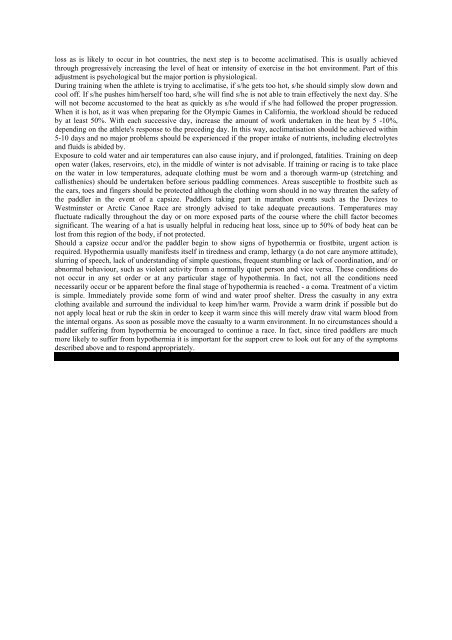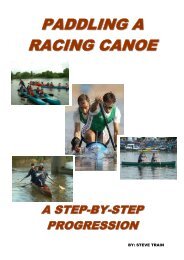The Science of Canoeing By Richard Cox
The Science of Canoeing By Richard Cox
The Science of Canoeing By Richard Cox
Create successful ePaper yourself
Turn your PDF publications into a flip-book with our unique Google optimized e-Paper software.
loss as is likely to occur in hot countries, the next step is to become acclimatised. This is usually achieved<br />
through progressively increasing the level <strong>of</strong> heat or intensity <strong>of</strong> exercise in the hot environment. Part <strong>of</strong> this<br />
adjustment is psychological but the major portion is physiological.<br />
During training when the athlete is trying to acclimatise, if s/he gets too hot, s/he should simply slow down and<br />
cool <strong>of</strong>f. If s/he pushes him/herself too hard, s/he will find s/he is not able to train effectively the next day. S/he<br />
will not become accustomed to the heat as quickly as s/he would if s/he had followed the proper progression.<br />
When it is hot, as it was when preparing for the Olympic Games in California, the workload should be reduced<br />
by at least 50%. With each successive day, increase the amount <strong>of</strong> work undertaken in the heat by 5 -10%,<br />
depending on the athlete's response to the preceding day. In this way, acclimatisation should be achieved within<br />
5-10 days and no major problems should be experienced if the proper intake <strong>of</strong> nutrients, including electrolytes<br />
and fluids is abided by.<br />
Exposure to cold water and air temperatures can also cause injury, and if prolonged, fatalities. Training on deep<br />
open water (lakes, reservoirs, etc), in the middle <strong>of</strong> winter is not advisable. If training or racing is to take place<br />
on the water in low temperatures, adequate clothing must be worn and a thorough warm-up (stretching and<br />
callisthenics) should be undertaken before serious paddling commences. Areas susceptible to frostbite such as<br />
the ears, toes and fingers should be protected although the clothing worn should in no way threaten the safety <strong>of</strong><br />
the paddler in the event <strong>of</strong> a capsize. Paddlers taking part in marathon events such as the Devizes to<br />
Westminster or Arctic Canoe Race are strongly advised to take adequate precautions. Temperatures may<br />
fluctuate radically throughout the day or on more exposed parts <strong>of</strong> the course where the chill factor becomes<br />
significant. <strong>The</strong> wearing <strong>of</strong> a hat is usually helpful in reducing heat loss, since up to 50% <strong>of</strong> body heat can be<br />
lost from this region <strong>of</strong> the body, if not protected.<br />
Should a capsize occur and/or the paddler begin to show signs <strong>of</strong> hypothermia or frostbite, urgent action is<br />
required. Hypothermia usually manifests itself in tiredness and cramp, lethargy (a do not care anymore attitude),<br />
slurring <strong>of</strong> speech, lack <strong>of</strong> understanding <strong>of</strong> simple questions, frequent stumbling or lack <strong>of</strong> coordination, and/ or<br />
abnormal behaviour, such as violent activity from a normally quiet person and vice versa. <strong>The</strong>se conditions do<br />
not occur in any set order or at any particular stage <strong>of</strong> hypothermia. In fact, not all the conditions need<br />
necessarily occur or be apparent before the final stage <strong>of</strong> hypothermia is reached - a coma. Treatment <strong>of</strong> a victim<br />
is simple. Immediately provide some form <strong>of</strong> wind and water pro<strong>of</strong> shelter. Dress the casualty in any extra<br />
clothing available and surround the individual to keep him/her warm. Provide a warm drink if possible but do<br />
not apply local heat or rub the skin in order to keep it warm since this will merely draw vital warm blood from<br />
the internal organs. As soon as possible move the casualty to a warm environment. In no circumstances should a<br />
paddler suffering from hypothermia be encouraged to continue a race. In fact, since tired paddlers are much<br />
more likely to suffer from hypothermia it is important for the support crew to look out for any <strong>of</strong> the symptoms<br />
described above and to respond appropriately.



